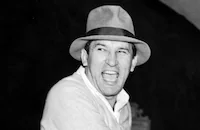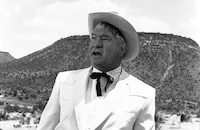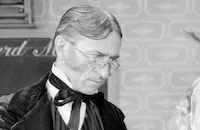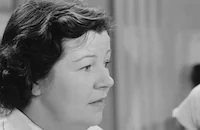I'll Be Seeing You

Brief Synopsis
Cast & Crew
William Dieterle
Ginger Rogers
Joseph Cotten
Shirley Temple
Spring Byington
Tom Tully
Film Details
Technical Specs

Synopsis
Social outcasts Mary Marshall and Sgt. Zachary Morgan meet while seated across from each other on a train bound for Pine Hill. Zach, a victim of shell shock and therefore a prisoner of his own mind, has just been granted a ten-day leave from a military hospital to try to readjust to daily life, while Mary has just been given a special eight-day furlough from prison so that she can spend the Christmas holiday with her aunt and uncle in Pine Hill. Each harbors his own secret, and consequently, Mary lies to Zach that she is a traveling saleslady on her way to spend the holidays with her family, while Zach tells Mary that he is going to visit his sister in Pine Hill. After the train pulls into the station, the two exchange names and Mary then goes to the Marshall home, where she is reunited with her uncle Henry, aunt Clara and cousin Barbara. Zach, meanwhile, checks into the YMCA. Unsure of herself after a three-year confinement in prison, Mary laments the loss of her youthful dreams of having a husband and family. Soon after, Zach phones and Mary invites him to dinner. After the meal, Zach tells Mary that he has no sister, but stopped in Pine Hill to be near her. He and Mary then attend a war movie, but Zach falls mute when Mary questions him about his own experiences in the war. While stopping at a café afterward, Zach panics when the soda jerk, who is afflicted with a facial tick, recounts being shell-shocked during World War I. Apprehensive that his affliction will also result in disfigurement, Zach flees the café but is unable to share his fears with Mary. Upon returning home, Mary, who is sharing Barbara's room, finds that Barbara has labeled her possessions. Realizing that Barbara distrusts her, Mary relates the circumstances that sent her to prison: After the death of her parents, Mary goes to work as a secretary. One night, her wealthy boss invites her to dinner at his apartment and Mary naïvely accepts, believing that he is inviting her to a party. Shocked to discover that she is the only guest, Mary is accosted by her drunken boss. While struggling to avoid his advances, Mary pushes him away, sending him to his death through an open window. After being convicted of manslaughter, Mary is sentenced to six years in prison. At the end of Mary's story, Barbara, who is touched by her cousin's misfortune, begs her forgiveness. The next day, Zach invites Mary to the lake and there explains his behavior of the previous night. After voicing his fears of becoming like the soda jerk, Zach asks Mary to help him believe in himself as she believes in herself. Over Christmas dinner at the Marshall house, Zach rhapsodizes about feeling at home with the family. Aware that her stay with the family is tempory, Mary becomes despondent and asks Sarah if she should tell Zach the truth. Sarah counsels her to remain silent. When Zach invites the Marshall family to a New Year's Eve party at the YMCA, Sarah buys Mary a new dress for the occasion. At the party, a senator solicits Zach's opinion as a soldier on political issues, and Zach outspokenly replies that each soldier is an individual and as such holds different opinions. While walking home with Mary after the dance, Zach is attacked by a dog and fends off the animal until its owner arrives to restrain it. As Mary bids Zach goodnight, she comments that he has regained his confidence and is now recovered. Knowing that they are both scheduled to leave the next day, Zach tries to discuss their future together, but Mary feigns sleepiness and asks to delay the discussion. Entering the house in tears, Mary confides her love for Zach to Sarah. Meanwhile, after jubilantly returning to his hotel room, Zach suffers a relapse but is restored by recalling the sound of Mary's voice. The next day, Zach comes to the Marshall house to say goodbye. While alone with Zach, Barbara inadvertently blurts out the details of Mary's prison sentence. Mary senses that something is wrong when Zach suddenly becomes distant and silently boards the train. Upon returning home, Mary discovers that Barbara has divulged her secret and bursts into tears. That night, as Mary approaches the gates of the state prison, Zach steps from the shadows to embrace her and declare his love.

Director

William Dieterle
Cast

Ginger Rogers

Joseph Cotten

Shirley Temple

Spring Byington

Tom Tully

Dare Harris

Chill Wills

Kenny Bowers
Dorothy Stone

Olin Howlin
John James
Eddie Hall
Joe Haworth
Jack Carr
Bob Meredith
Robert Dudley

Margaret Bert
Mickey Laughlin
Hank Tobias

Gary Gray

Larry Williams
Nolan Leary
Cliff Lyons
Brandon Beach
Crew
Fred Ahern
Daniele Amfitheatrof
James Basevi
John R. Cosgrove
Richard De Weese
Sammy Fain
Lowell J. Farrell
L. B. Freeborg
Tony Gaudio
Ann Harris
Edith Head
Arthur Johns
Irving Kahal
Hal C. Kern
Mark-lee Kirk
Emile Kuri
Don Lopez
Lou Lusty
Kenneth Meade
Earl B. Mounce
Paul Neal
Marion Parsonnet
Elmer Raguse
William Riddle
Lt. Col. Andrew I. Rosenberg
Dore Schary
Charles W. Schellenberger
David O. Selznick
Lt. Col. Frank H. Shepardson
Holbrook Todd
Rex Wimpy
Earl B. Wooden
William H. Ziegler

Photo Collections
Videos
Movie Clip




Hosted Intro
Film Details
Technical Specs

Articles
I'll Be Seeing You
I'll Be Seeing You, directed by William Dieterle, was the first production of David O. Selznick's Vanguard Films, and he had hired Dore Schary to oversee the operation. Selznick gave Schary the go-ahead to make I'll Be Seeing You -- which had begun life as a radio play, Double Furlough, written by Charles Martin -- but in his autobiography, Schary claimed that the two men argued over various aspects of the picture's production. Schary claimed, for example, that originally Selznick didn't want Cotten to play the male lead, though he later relented. (For a time, Joan Fontaine was also being considered for the role of Mary.)
According to the film critic and historian Emmanuel Levy, there were other problems as well. Selznick was unhappy with a pivotal scene in the picture, in which Mary learns that Barbara has tattled to Zachary about her past. According to Levy, Selznick went to George Cukor, who was at that point working on Winged Victory, and asked him to direct a replacement scene, which Selznick himself had written. The original scene, as shot by Dieterle, had apparently involved tears and histrionics. Cukor was going for something more restrained, and when Temple first attempted the reworked scene, Cukor stopped her, shouting, "Where did you learn this business?" Oblivious, willfully or otherwise, to Temple's distress, he went further: "That's awful!"
Temple, Levy notes, begged Cukor to give her a few minutes so she could produce some real tears. "Give me five minutes and you'll get a good cry." "Cry, nothing," Cukor shot back. "I want emotion, not tears." After twelve takes, Cukor got what he wanted and put his arm around the actress, telling her she'd finally given him what he was looking for. But the experience rattled Temple, and she never forgot it.
It's easy to see why. Temple had been the biggest child star of the 1930s and at that point was making an awkward transition into more adult roles. (She would continue to work in films through the 1940s, before leaving acting altogether and becoming more active in politics, in the late 1960s.) But then, I'll Be Seeing You is a picture that's all about transitions. For one thing, it's an early example of the way Hollywood was attempting to grapple with the possible after-effects of World War II, looking ahead to the point at which the nation's servicemen would return home, many of them facing difficult transitions. The finest and most sensitive of these pictures may be William Wyler's 1946 The Best Years of Our Lives. But I'll Be Seeing You, made two years earlier, deserves credit for taking those first steps into the thorny territory of postwar adjustment. If the picture is a little awkward in places, there's also something heartfelt and earnest about the way it treats these two lonely characters, both of them hoping to reclaim their lives after suffering very different kinds of trauma.
The notoriously stuffy New York Times critic Bosley Crowther loved the picture, urging his readers to see it immediately: "This is a pressing recommendation that as many of you see it as can." He was particularly struck by Cotten's performance, writing, "He plays the shell-shocked veteran with supreme restraint and with a calm and determined independence that beautifully reveals his pain and pride."
Weighing in years later, Pauline Kael wasn't nearly as keen on the picture's merits: "This Selznick project originated in a radio play (by Charles Martin), and it may have sounded like a good movie idea. But oh, my!" She went on to cite certain details that bothered her, chiefly that Mary's aunt, uncle and cousin seem so fixated on her status as a convict "that one imagines that she'd have preferred to remain in the jug."
Well, maybe. But Rogers' performance equals the one given by Cotten, though it's very different. Her character is more reactive than proactive. But when Cotten suffers, she feels it - her face shows a kind of unforced empathy, as if she were reaching out to all the pain in him, finally giving an outlet to feelings that she'd never allow for herself.
Rogers, at this point, was also in a time of transition. She'd spent the 1930s as a breezy, fleet-footed wisecracker (and, of course, as Fred Astaire's perfect partner), but by the 1940s she was showing a gift for tougher, weightier roles as well. She knew how to keep melodramatic material from going comically over the top; in pictures like the 1940 Kitty Foyle (for which she won an Oscar®), she could be intensely moving without ever succumbing to sentimentality. That's a gift she also brings to I'll Be Seeing You. The picture may overstretch its boundaries in some ways. But it's also brushed with shadows of melancholy, a story about people facing radical personal challenges, even as their country is changing radically, if quietly, around them.
Producer: Dore Schary, David O. Selznick (uncredited)
Director: William Dieterle, George Cukor (uncredtied)
Screenplay: Marion Parsonnet, Charles Martin (play)
Cinematography: Tony Gaudio
Music: Daniele Amfitheatrof
Film Editing: William H. Ziegler, Holbrook N. Todd (uncredited)
Cast: Ginger Rogers (Mary Marshall), Joseph Cotten (Zachary Morgan), Shirley Temple (Barbara Marshall), Spring Byington (Mrs. Marshall), Tom Tully (Mr. Marshall), John Derek (Lt. Bruce), Chill Wills (Swanson).
BW-85m.
Stephanie Zacharek
SOURCES:
IMDb
The New York Times
Pauline Kael, 5001 Nights at the Movies, Holt, Rinehart and Winston, 1982
Emmanuel Levy, www.emanuellevy.com/comment/ill-be-seeing-you-cukor-directs-shirley-temple-6/
Patricia King Hanson, Amy Dunkleberger, American Film Institute Catalog of Motion Pictures Produced in the United States; Feature Films 1941-1950 Indexes, Volume 2, University of California Press, 1999

I'll Be Seeing You
Quotes
Trivia
Director George Cukor was replaced by David O. Selznick.
Notes
The working titles of this film were With All My Heart and Double Furlough. A contemporary source indicates that the radio play Double Furlough starred James Cagney and Gertrude Lawrence, but information about its broadcast has not been located. Hollywood Reporter news items provide the following information about the production: In January 1944, John Cromwell was slated to direct the film. In late Feb, a news item announced that Joan Fontaine, who was to play the female lead, was forced to withdraw due to previous commitments. Although a Hollywood Reporter production chart places Ralph Morgan, Stanley Ridges, Ruth Brennan and Wilfred Jillson in the cast, their appearance in the released film has not been confirmed. In April 1944, other Hollywood Reporter news items added Stewart Garner and George Turner to the cast, but their appearance in the released film has not been confirmed. Locations shots were filmed at Big Bear Lake, the RKO Ranch and at Chatsworth, CA, including the Iverson Ranch, according to other Hollywood Reporter news items. Modern sources add Walter Baldwin to the cast.
This was the first production of David O. Selznick's Vanguard Films. In a memo from Selznick reprinted in a modern source, the producer noted that he had hired Dore Schary to oversee Vanguard, and supported him in his decision to buy this story. According to the memo, Schary took umbrage at some of Selznick's criticisms of the script and later balked at Selznick's insistence that he re-edit the picture. In his autobiography, Schary claimed that Selznick originally forbid him to cast Joseph Cotten as the male lead, but later relented. Schary added that Selznick wanted to use Noel Coward's "I'll See You Again" as the film's tile, but was unable to obtain the rights and so used "I'll Be Seeing You" instead. Another modern source noted that Selznick was displeased with William Dieterle's direction of the scene in which "Barbara" confesses to "Mary" that she told "Zach" about her prison record. According to that source, Selznick wrote a replacement scene and hired George Cukor to direct it. On December 24, 1945, Lux Radio Theater broadcast a radio version of this story starring Joseph Cotten. I'll Be Seeing You marked the first time that actor John Derek (1926-1998), who was billed as "Dare Harris," received an onscreen credit. Derek had previously appeared in a bit role in Selznick's Since You Went Away.
















